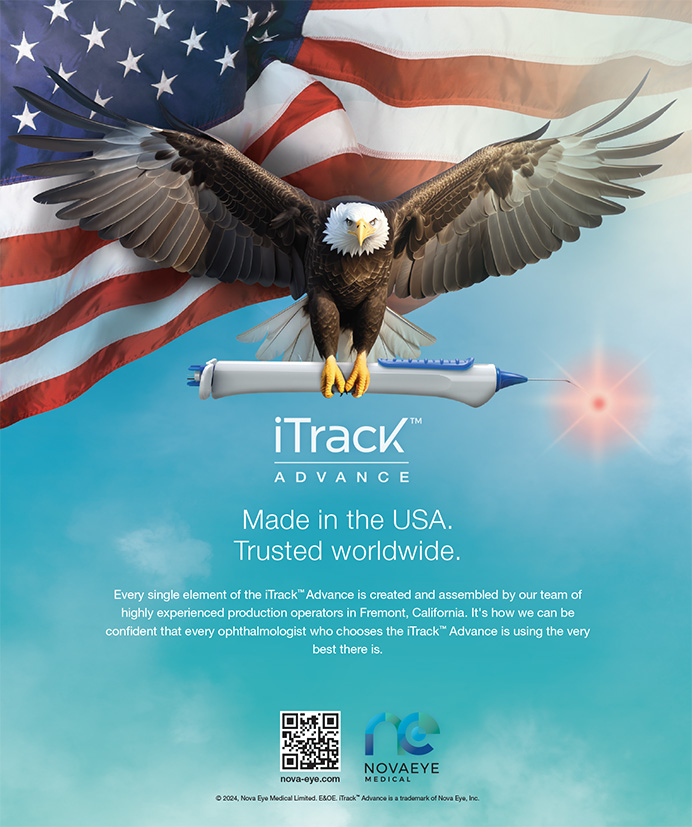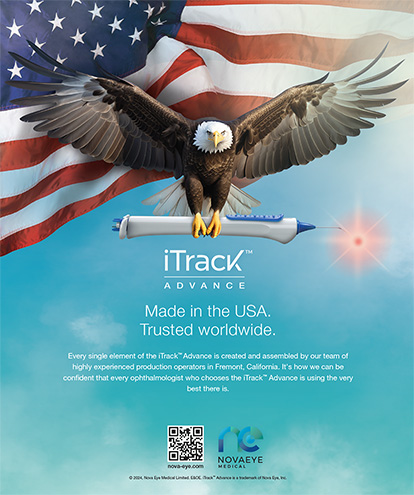Corneal surgeons will tell you that you must treat the delicate ocular surface with care both pre- and postoperatively in order to minimize surgical complications. Here, two specialists share their methods and techniques for promoting corneal health.
Eric Donnenfeld, MD
Preoperative evaluation is the key. I am particularly interested in the incidence of dry eye after LASIK. The most important step a refractive surgeon can take to prevent this condition is the preoperative patient evaluation. He must determine whether the patient is a good LASIK candidate, and, if the patient is not, the surgeon has the ability to treat the ocular surface to improve the patient's candidacy.
To that end, I think that refractive surgeons should use supravital dyes for conjunctival staining, as this is the earliest sign of dry eye and occurs well before corneal staining. I prefer Lissamine Green supravital dye (Accutome, Malvern, PA) because it is less toxic and less irritating to the eye, and it will stain the conjunctiva in a v-shaped distribution. If patients describe symptoms of dry eye but show no lissamine green conjunctival staining, I feel they are very good candidates for surgery. For patients who demonstrate conjunctival staining, I try to optimize their ocular surface before surgery. I prefer not to perform refractive surgery on patients who have frank corneal staining.
Optimize the ocular surface. First, I try to determine why a patient has dry eyes. If they have meibomian gland dysfunction, such as blepharitis, I treat the blepharitis. Often, I use oral doxycycline 100 mg b.i.d. for 2 weeks and then q.d. for 1 month. Recently, however, I began using TheraTears Nutrition (Advanced Vision Research, Woburn, MA), a nutritional product that contains high doses of eicosopentanoic acid and omega-3 fatty acids. I prescribe two pills b.i.d., and the product opens the oil glands so patients can secrete their own oils. I also use Refresh Endura lubricant eye drops (Allergan, Inc., Irvine, CA), which also have a lipid tear component and help stabilize the ocular surface. Hot compresses and lid hygiene further aid in stabilizing the tear film.
For patients who have aqueous-component dry eye, I use preserved tears such as Refresh, TheraTears, and Genteal Gel (CIBA Vision, Atlanta, GA). I also use Restasis cyclosporine ophthalmic emulsion 0.05% (Allergan, Inc.), which recently gained FDA approval. I prescribe Restasis b.i.d. for 3 months preoperatively to increase tear production and reverse the dry eye. This pretreatment can turn a poor or borderline candidate into a good candidate for refractive surgery.
Treat every LASIK patient for dry eye. I believe every patient who undergoes LASIK has dry eye postoperatively because of the resultant loss of corneal sensation, which decreases the innervation of the lacrimal gland. Patients cannot feel the symptoms of dry eye because their corneas are anesthetic. In order to manage dry eye postoperatively, I give my LASIK patients a mandatory artificial tears course. I use nonpreserved tears for the first 2 days, after which I prescribe transiently-preserved tears q.i.d. (whether the patient needs them or not) because they help to stabilize healing.
I conducted a study on corneal sensation in dry eye in which I found that patients who have the condition preoperatively benefit from a nasal hinge flap (rather than a superior hinge flap) because it better preserves corneal innervation and reduces corneal staining in dry eye after LASIK. Check corneal sensation. Patients who have anesthetic corneas are poor candidates for surgery. Although I feel comfortable operating on diabetics, I always check their corneal sensation prior to surgery. Approximately 10% of diabetics will have corneal anesthesia. I use a Cochet-Bonnet aesthesiometer (Luneau Ophthalmologia, Chartres, France) to check sensation, but you may also use a cotton swab or a wisp of cotton. If the patient receives moderate or high levels of anesthesia during the preoperative examination, I neither perform LASIK, nor do I perform the procedure on patients who have preoperative basement membrane dystrophy. I think that most doctors would agree with this decision. I perform a cotton swab test to gauge the adherence of the basement membrane dystrophy. If patients have any significant dystrophy, I prefer to treat them with PRK. Not only does basement membrane dystrophy increase the risk of corneal abrasions (which heightens the risk of flap slippage, striae, infections, and DLK), but it also diminishes the patient's visual acuity by directly affecting the regularity of the ocular surface. Performing LASEK would preserve the damaged epithelium, which you want to scrape away.
Use prophylaxis. I think fluoroquinolones are clearly the best choice in antibiotics because they cover the organisms that cause infections. My colleagues and I are publishing three papers regarding infections after PRK,1 infections after LASIK,2 and methicillin-resistant Staphylococcus aureus infections after refractive surgery.3 The infections commonly seen after LASIK and PRK are either opportunistic or gram-positive infections. Patients who are healthcare professionals are particularly vulnerable to colonization, most notably by an organism called methicillin-resistant S. aureus, which is not sensitive to any topical drugs currently available. Vancomycin is the only effective treatment for this infection. The new fluoroquinolone agents, gatifloxacin and moxifloxacin, will treat infections much more effectively than current agents, and I would strongly recommend these fourth-generation fluoroquinolones for the routine prophylaxis of the eyes of patients who work in a hospital environment.
Infectious until proven otherwise. Any infiltrate I see postoperatively in a LASIK patient I consider infectious until proven otherwise. The opportunistic infections often take 2 to 4 weeks to present. Although a patient's eye may be quiet, pain-free, and have an infiltrate that develops 2 to 4 weeks postoperatively, it probably is infectious and should be cultured. The most common organism I see in that stage is atypical mycobacteria, which do not grow on conventional media and must be cultured on media such as Lowenstein-Jensen.
LASIK after transplants. One of my specialties is performing LASIK in patients who have undergone corneal transplants—a wonderful technique. However, potentially problematic cases include patients who have pseudophakic keratopathy and those who have peripherally edematous corneas that will not adhere well after LASIK. I advise making smaller flaps on patients who have pseudo-phakic keratopathy with endothelial dysfunction. Also, place a contact lens on these patients and follow them more carefully. Ask them to wear an eye shield for a few days to protect their flaps. After keratoconous, I have concerns about making a flap in an eye that is already ectatic. I currently perform PRK using mitomycin C with these patients instead of LASIK and have had very good results.
Shachar Tauber, MD
Inspect the eyelid position. As we all remember from our training, good corneal results require a healthy eyelid. Note preoperative ptosis and inform the patient of your findings. Remember that ptosis may occur following the refractive procedure due to the speculum, inflammation, or medications used postoperatively. It is also important to address and treat, if indicated, preoperative lagophthalmos. It may be idiopathic, related to a previous infection, trauma, or medical condition. Associated exposure keratopathy, tear film insufficiency, or a neurotrophic cornea may preclude any refractive surgery on the cornea.
Evaluate the eyelid margin. Both the patient's medical history and a physical examination are critical to evaluating him for surgery. A suspicious history or the presentation upon slit lamp examination of acne rosacea, atopy, or blepharitis warrants modifying your treatment prior to corneal refractive surgery. Recent data4 have demonstrated a potential link between DLK and patients with atopy. Be on guard for the allergic eye-rubbing patient. Patients taking oral antihistamines may have trouble with dry eye symptoms after undergoing corneal refractive surgery. Moreover, these patients may chronically rub their eyes and thus may have trouble with slipped flaps or striae post-LASIK, or with poorly healing corneal epithelial surfaces after LASEK/PRK. Work presented at the Royal Hawaiian Eye Meeting in January 2003 suggests that these patients can be treated by ceasing antihistamine usage and replacing it with a nasal steroid, as well as starting the patient on a topical mast cell stabilizer.5
Eric Donnenfeld, MD, is a partner in Ophthalmic Consultants of Long Island, and is Co-Chairman of Corneal and External Disease at the Manhattan Eye, Ear and Throat Hospital in New York. Dr. Donnenfeld may be reached at (516) 766-2519; eddoph@aol.com.Shachar Tauber, MD, is Assistant Professor and Director of Cornea, External Disease, Contact Lens, and Refractive Surgery for the Department of Ophthalmology and Visual Sciences, Yale University School of Medicine. He is also Medical Director of the Yale New Haven Eye Laser Center. Dr. Tauber may be reached at (203) 752-2020; shachar.tauber@yale.edu.
1. Donnenfeld ED, et al. Infectious keratitis following PRK. Ophthalmology. (In press).
2. Donnenfeld ED, et al. Infectious keratitis following LASIK. J Cataract Refract Surg. (In press).
3. Donnenfeld ED, et al. Methicillin resistant Staphylococcus aureus keratitis following refractive surgery. Paper to be presented at: The annual ASCRS meeting; April 2003; San Francisco, CA.
4. Boorstein S, Henk HJ, Elner VM. Atopy: a patient-specific risk factor for diffuse lamellar keratitis. Ophthalmology. 2003;1:131-137.
5. Mah, FS, Dhaliwal, DK. Why should refractive surgeons be concerned about ocular allergy? Paper presented at: The Royal Hawaiian Eye Meeting; January 2003; Maui, Hawaii.


